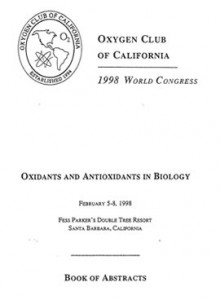| Title | Superoxide and Nitric Oxide Production by Leukocytes of Diabetic Patients. Effect of Natural Antioxidant Bio-Normalizer |
|---|---|
| Year | 1998 |
| Author | L.G. Korkina; E.A. Ostrachovich; E. Michal’ chik; I.B. Afanas;ev; |
| Publisher | Oxygen Club of California 1998 World Congress |
 Superoxide and Nitric Oxide Production by leukocytes of Diabetic Patients Effects of Natural Antioxidant Bio–Normalizer (BN)
Superoxide and Nitric Oxide Production by leukocytes of Diabetic Patients Effects of Natural Antioxidant Bio–Normalizer (BN)
L. Korkina1, E. Ostrachovitch2, E. Michal‘chik1, I. Afanas’ev2
1 Russian Institute of Pediatric Hematology;
2 Vitamin Research Institute, Russia
This study was designed to determine the effects of BN a natural functional food produced by fermentation of papaya fruits and some tropical herbs, on clinical conditions, metabolic parameters and oxidant/antioxidant status of diabetic patients. The randomized double-blind placebo-controlled clinical trials have been carried out in Russian Center of Diabetes. At the first stage of the study, two groups of infection free patients with insulin-dependent diabetes mellitus of >10 years duration (group 1, IDDM, n=30) and insulin-independent DM of <2 years duration (group 2, IIDM, n=26) were investigated for evidence of imbalance of O2 – /NO production by circulating polymorphonuclear and mononucluear leukocytes. Healthy controls (group 3, n=20) were matched for age and sex. We examined the NO release from freshly isolated and PMA- or zymosan-activated leukocytes by measuring the nitrite (NO2 -) levels by Griess reaction. O2 production was examined by the ferrocytochrome c and lucigenin chemiluminescence assays. Activities of leukocytes CuZnSOD, MnSOD and catalase were determined in the ethanol-chloroform cell extracts. Results were analyzed according to type of diabetes, glucose control, duration of disease and presence of vascular complications. The diabetic patients had an impaired oxidant/antioxidant balance, which depended mainly on type of diabetes and duration of disease. Thus, IDDM characterized by suppressed NO and O2 production and MnSOD and catalase activities. IIDM leukocytes produced either highly elevated levels of both O2– and NO or decreased level of O2 – , which had a negative correlation with duration of disease. We found that the BN but not placebo administration (6g a day for 1 month) improved significantly clinical conditions (especially, vascular complications and wound healing) in more than 80% patients and their metabolic parameters decreasing the main DM markers in patients’ blood and urine. A daily requirement of insulin decreased in average by 20-25%. Besides, the course of BN therapy led to the restoration of practically normal level of O2 – and NO production by cells. BN increased substantially activities of IDDM MnSOD and catalase and did not change CuZnSOD. To evaluate the mechanism of clinical efficacy, BN was used in the experimental model of streptozotocin-induced DM as well. Using specific antibodies and immunohistochemical methods, we found that BN normalized frequency of iNOS-positive cells in islets and brain from acutely diabetic rats.